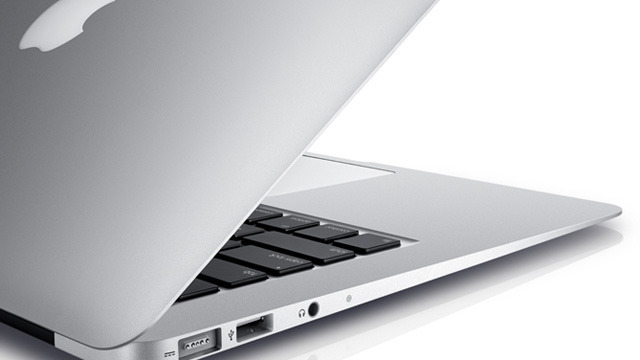
At long last, Apple released Intel’s highly anticipated Sandy Bridge updates on both the MacBook Air and Mac mini earlier this month. However, many of these machines—along with the 13″ MacBook Pro introduced earlier this year—rely solely on Intel’s integrated graphics, a move that raised eyebrows among users allergic to the reduced performance that often comes with Intel’s integrated GPUs. The move from Intel’s integrated GPU from the 320M indeed has some trade-offs, but some investigation reveals that performance is, as we suspected, largely the same.
While Intel’s reputation for graphics hasn’t gone much beyond “just barely enough to suffice,” the integrated GPU in Sandy Bridge processors represents Intel’s first serious effort to address performance. That performance generally compares to low-end discrete GPUs, while in many cases reducing overall power consumption.
We thought it would be useful to examine the differences between Apple’s previous integrated solution—the 320M—and Intel’s HD Graphics 3000. Given that Intel’s next-generation architecture, codenamed Ivy Bridge, is expected to offer significantly improved graphics, we can draw some conclusions about why Apple decided to make the switch now rather than later.
NVIDIA past
Previous low-end machines from Apple paired an Intel Core 2 Duo processor with an NVIDIA controller that had an integrated GPU. Such controllers combine functions of northbridge and southbridge typical in older PCs, including RAM access, I/O, and other functions, as well as integrated graphics. The first controller Apple widely adopted across its computer line was the 9400M, which included a 16-core GPU that ran at a nominal speed of 580MHz, and was good for 54Gflops of processing power.
Apple later adopted an improved version of this controller dubbed the 320M. This part was made exclusively for Apple, though there are similarities with NVIDIA’s 310M mobile solution. This Apple-only variation had 48 shader cores at a nominal speed of 450MHz and was good for roughly 130Gflops. (Neither Apple nor NVIDIA would confirm the speed to us, but it is estimated from what little information is public about the 320M.)
With the 9400M and later the 320M serving as a baseline, Apple began architecting its operating system and many of its software applications to rely more and more on the capabilities of the GPU to optimize performance. Apple also pushed for a standardized way for programmers to leverage GPU and other processing power for performance enhancements, and worked with multiple vendors to implement the Open Compute Language, otherwise known as OpenCL. The standard, largely based on NVIDIA’s GPGPU language CUDA, was finished just in time for Apple to wrap support for it into Snow Leopard.
Unfortunately for Apple (and perhaps NVIDIA), Intel disputed NVIDIA’s legal standing to build controllers for its post-Core 2 Duo processors. That meant if Apple wanted Intel’s new Clarkdale or Arrandale processors, it would have to use Intel controllers. Ultimately, Apple decided to move some of its machines to these new processors and combine them with discrete GPUs, largely from NVIDIA. For Apple’s most compact models, however—including the 13″ MacBook and MacBook Pro, MacBook Air, and Mac mini—the company was left with two options: rely on the decidedly lackluster performance of Intel’s integrated graphics, or stick with older processors and NVIDIA’s 320M.
The latter is exactly what Apple did. Several of Apple’s early Intel-based Macs relied on Intel integrated graphics, and those who used those machines know well that graphics performance was barely acceptable. (I know only too well; I used a first-generation MacBook as my main machine for nearly five years.) Intel’s integrated solutions would have been a major step backwards in performance, despite the improved CPU speed. With Apple increasingly relying on the GPU to make both its OS and its applications run smoother and faster, it simply wasn’t a worthwhile trade-off.
With Clarkdale, integrated graphics were still tied to the controller. But with Arrandale, Intel packaged an integrated GPU on a separate die inside the same package as the CPU; if you had an Intel CPU, you also had an Intel IGP whether you wanted it or not. Intel took that integration one step further with Sandy Bridge by building the GPU on the same die as the CPU, connected directly to it and a shared L3 cache. This level of integration has given Intel’s graphics solution a serious boost in performance.
Intel present
The integrated graphics Intel bundles with its Sandy Bridge processors is the Intel HD Graphics 3000. (Some desktop-only processor models include the HD 2000, which we won’t discuss here as none of Apple’s machines use it.) Along with fixed-function and video encoding and decoding hardware, the HD 3000 includes 12 programmable “execution units” that run at a nominal speed of 350MHz on the mobile processors Apple uses in its low-end machines. However, like the CPU cores, the HD 3000 can run in a limited “turbo” mode clocked as high as 1100MHz. Intel says that this design is good for 100-130Gflops.
Looking strictly at raw gigaflops, the HD 3000 should be roughly comparable to the 320M. But there are some architectural differences that give NVIDIA’s GPU some advantages. For instance, the 320M shuffles data around internally 256 bits at a time, whereas the HD 3000 moves data 128 bits at a time. The HD 3000’s execution units are also comparatively limited. For instance, it lacks the small cache area for optimized communication between threads running on its 12 EUs. (This is why the HD 3000 isn’t compatible with OpenCL, despite early Intel indications that it would be.)
With these limitations, why would Apple elect to use the HD 3000? It turns out that for most applications—in other words, anything that’s not gaming—the HD 3000 does perform about as well as the 320M. While Intel’s EUs are roughly on par with NVIDIA’s shader cores, its fixed-function hardware doesn’t quite compare—Intel just hasn’t thrown resources at graphics the way NVIDIA (or AMD) would. On the other hand, Intel’s CPU integration gives it a major boost in memory access—often a major bottleneck in integrated graphics, which use a small bit of system RAM instead of using its own dedicated memory. And Intel’s drivers can also shuffle some functions to one or more of the CPU cores for added optimization.
The other reason is that Sandy Bridge CPUs, clock for clock, are significantly faster than the Core 2 Duos that they replace in Apple’s line up. With roughly comparable graphics performance and significantly improved CPU performance in the same power envelope as previous designs, it finally made sense for Apple to make the switch.
Take a look at some recent benchmarks comparing performance between last fall’s MacBook Air and the Sandy Bridge update Apple released last week. CPU-bound operations, like MP3 encoding or importing a Word file into Pages, run about twice as fast on Sandy Bridge machines. A Cinebench test that used the CPU only turned in an impressive 136 percent speed boost in Macworld’s labs.
However, tests using Call of Duty 4 and Portal 2—games that rely heavily on GPU power—show that the 320M still has an edge with its superior core design. While the older MacBook Air was no gaming powerhouse, its 320M consistently turned in frame rates over 30. Intel’s HD 3000, though, chugged along in CoD4 at about 25fps and in Portal 2 at about 27fps. So while you can game on Apple’s latest hardware, most serious gamers probably wouldn’t want to.

Effectively, Apple’s updated low-end hardware runs about twice as fast for most applications as last year’s models for about the same money. Games won’t run as well, but then again, they didn’t run that well on this hardware to begin with.
Intel future?
There’s more good news, however. The next major update to Intel’s processors, likely to start shipping in about a year, will include even more enhancements to the integrated graphics. “The way Intel thought about graphics for the longest time was, ‘if there’s some room on the die, you can use it for graphics,'” microprocessor analyst and occasional Ars contributor David Kanter told us. In other words, graphics capabilities were usually sort of an afterthought, something good enough to fill in a check box. “Now the demands from ultraportables are higher, and Intel is changing that,” Kanter said.
Sandy Bridge represents the first major step in that direction from Intel. Shrinking down from a 32nm process to a 22nm process enabled by Intel’s tri-gate 3D transistor technology will give the company the ability to dedicate more die area to graphics resources. That includes full compatibility with the OpenCL 1.1 spec, among other enhancements, and that alone will bring a performance boost to Mac users. It is also expected to support the latest 3D programming models, including OpenGL 4. This time next year, “Intel integrated graphics” may no longer be the computing equivalent of a four-letter word.
[Source:- Arstechnica]










